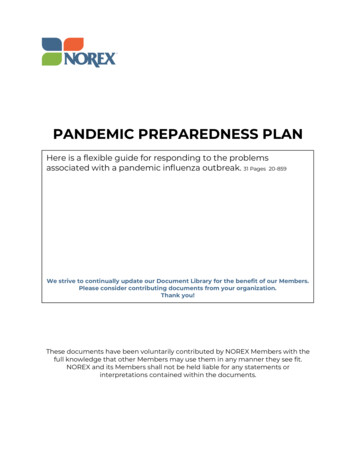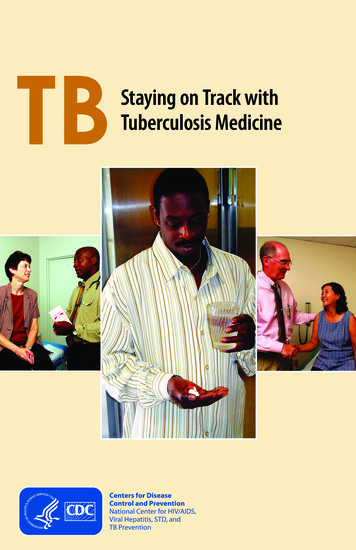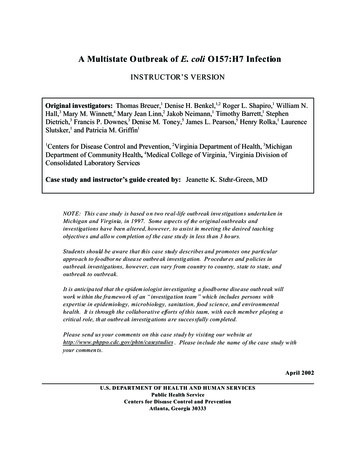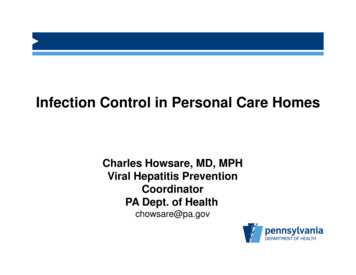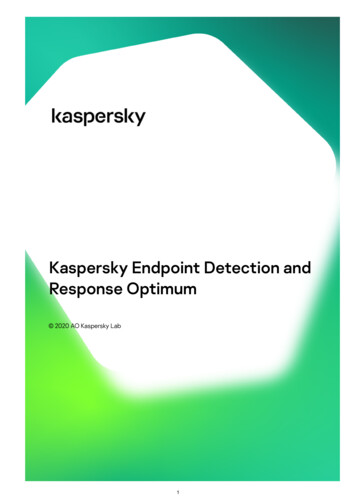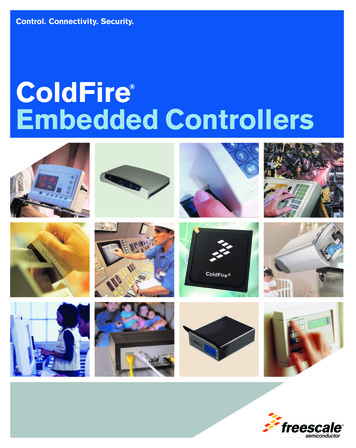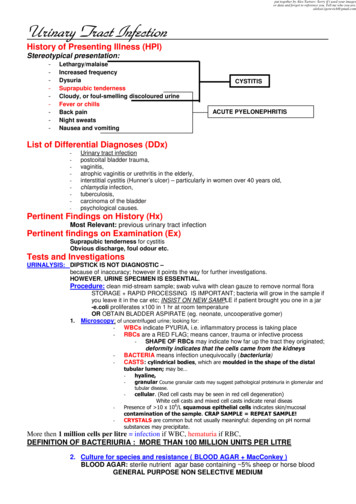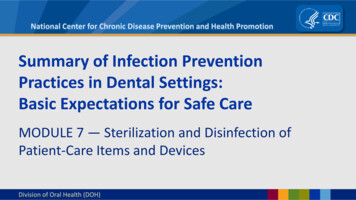
Transcription
Summary of Infection PreventionPractices in Dental Settings:Basic Expectations for Safe CareMODULE 7 — Sterilization and Disinfection ofPatient-Care Items and Devices
MODULE 7 — Sterilization and Disinfection of Patient-Care Items and DevicesModules in the Slide Series1.2.3.4.5.6.7.IntroductionHand HygienePersonal Protective EquipmentRespiratory Hygiene/Cough EtiquetteSharps SafetySafe Injection PracticesSterilization and Disinfection of Patient-Care Items and Devices (thismodule)8. Environmental Infection Prevention and Control9. Dental Unit Water Quality10. Program EvaluationSlide 2
MODULE 7 — Sterilization and Disinfection of Patient-Care Items and DevicesCategories of Patient-Care Items Three categories:1. Critical.2. Semicritical.3. Noncritical. Based on intended use and the potential risk ofdisease transmissionSlide 3
MODULE 7 — Sterilization and Disinfection of Patient-Care Items and DevicesCritical Items Penetrate soft tissue or contact bone,enter into or contact the vascular systemor other normally sterile tissue. Greatest risk of transmitting infection. Must be heat sterilized between use, orsterile single-use, disposable devicesmust be used. Examples: surgical instrumentsand periodontal scalers.Slide 4
MODULE 7 — Sterilization and Disinfection of Patient-Care Items and DevicesSemicritical Items Contact mucous membranes or non-intactskin (e.g., exposed skin that is chapped,abraded, or has dermatitis).Lower risk of transmission.Should be heat sterilized or high-leveldisinfected.Examples: mouth mirrors, amalgamcondensers, and reusable impression trays.NOTE: If a semicritical item is heat-sensitive, DHCP should replace it with a heat-tolerant or disposable alternative.If none are available, the item should, at a minimum, be processed using high-level disinfection.Slide 5
MODULE 7 — Sterilization and Disinfection of Patient-Care Items and DevicesSemicritical ItemsSpecial Considerations—Dental Handpieces Follow manufacturer’s instructions tosafely reprocess dental handpieces andaccessories (e.g., low-speed motor,reusable prophylaxis angles). Clean and heat sterilize between patient uses. Do not subject the handpiece to high-leveldisinfection and do not simply wipe the surfacewith a low-level disinfectant.Slide 6
MODULE 7 — Sterilization and Disinfection of Patient-Care Items and DevicesSemicritical ItemsSpecial Considerations—Digital Sensors Follow manufacturer’s instructions to safelyreprocess digital radiography equipment. Ideally, barrier protection should be used,followed by cleaning and heat sterilizationor high-level disinfection between patients.–If the item cannot tolerate these procedures, then at minimum, barrierprotection should be used, followed by cleaning and disinfection with anintermediate-level disinfectant between patients.Slide 7
MODULE 7 — Sterilization and Disinfection of Patient-Care Items and DevicesNoncritical Items Contact intact skin. Barrier protect or clean and disinfect(if visibly soiled) using a low tointermediate-level(i.e., tuberculocidal) disinfectant. Examples: x-ray head or cone,facebows, blood pressure cuff.Slide 8
MODULE 7 — Sterilization and Disinfection of Patient-Care Items and DevicesSingle-Use (Disposable) Devices Intended for use on one patient duringa single procedure. Usually not heat-tolerant. Cannot be reliably cleaned. Do NOT reprocess. Examples: syringe needles, prophylaxiscups, and plastic orthodontic brackets.Slide 9
MODULE 7 — Sterilization and Disinfection of Patient-Care Items and DevicesInstrument Processing Follow manufacturer’s instructions for reprocessing (i.e.,cleaning, packaging, disinfecting, sterilizing) reusable dentalinstruments and equipment.–Maintain manufacturer’s instructions (ideally) in or near thereprocessing area. Use FDA-cleared devices and supplies for cleaning, packaging,and heat sterilization. Should be assigned to DHCP with training in the requiredreprocessing steps.Slide 10
MODULE 7 — Sterilization and Disinfection of Patient-Care Items and DevicesInstrument Processing Area Use a designated processing area to control quality and ensuresafety. Divide processing area into work areas:–––– Receiving, decontamination, and cleaning.Preparation and packaging.Sterilization.Storage.Devices and instruments should flow from highcontamination areas to clean and sterile areas.Slide 11
MODULE 7 — Sterilization and Disinfection of Patient-Care Items and DevicesCleaning Cleaning should always occur before disinfectionor sterilization.– Presence of soil can compromise the disinfection orsterilization process.Automated or manual.Minimize exposure potential.Use carrying containers to transport contaminated instruments.Wear personal protective equipment (e.g., heavy duty utilitygloves, mask, protective eyewear and clothing).Slide 12
MODULE 7 — Sterilization and Disinfection of Patient-Care Items and DevicesAutomated Cleaning Ultrasonic cleaner. Instrument washer. Washer-disinfector.Slide 13
MODULE 7 — Sterilization and Disinfection of Patient-Care Items and DevicesManual Cleaning If not performed immediately,soak instruments until ready toclean to prevent debris fromdrying on instruments. Wear heavy-duty utility gloves,mask, eyewear, and protectiveclothing.Slide 14
MODULE 7 — Sterilization and Disinfection of Patient-Care Items and DevicesPreparation and Packaging Wrap, package, or place instruments incontainers before heat sterilization.– Instruments should be thoroughly dry before theyare packaged, wrapped, or otherwise contained.Follow manufacturer’s instructions.–For example: open hinged instruments,disassemble instruments if required, and ensurethat packaging materials are compatible withthe method of heat sterilization being used.Slide 15
MODULE 7 — Sterilization and Disinfection of Patient-Care Items and DevicesPreparation and Packaging (Continued) Place a chemical indicator insideeach package.– If the internal chemical indicator cannot be seenfrom the outside, place another indicator on theoutside of the package.Label the package with the following:––––Sterilizer number.Cycle or load number.Date of sterilization.Expiration date, if applicable.Slide 16
MODULE 7 — Sterilization and Disinfection of Patient-Care Items and DevicesHeat-Based Sterilization Use FDA-cleared devices and follow manufacturer’sinstructions. Steam under pressure (autoclaving):–Gravity displacement.–Pre-vacuum. Dry heat. Unsaturated chemical vapor.Slide 17
MODULE 7 — Sterilization and Disinfection of Patient-Care Items and DevicesLiquid Chemical Sterilant or Disinfectants Only for heat-sensitive critical andsemicritical devices. Highly toxic. Follow manufacturer’s instructions(e.g., regarding dilution, immersion time, andtemperature) and safety precautions precisely. Heat-tolerant or disposable alternatives are available.Slide 18
MODULE 7 — Sterilization and Disinfection of Patient-Care Items and DevicesSterilization Monitoring: Types of Indicators Mechanical:– Chemical:– Change in color when physical parameter is reached.Biological (spore tests):– Measures time, temperature, and pressure.Uses biological spores to asses the sterilization process directly.Indicators are specific to the type of sterilization used.Slide 19
MODULE 7 — Sterilization and Disinfection of Patient-Care Items and DevicesMechanical Monitoring Monitor each load with mechanical (physical) e 20
MODULE 7 — Sterilization and Disinfection of Patient-Care Items and DevicesChemical Monitoring Use an internal chemical indicator in everypackage. If the internal indicatoris not visible from the outside, then alsouse an external indicator.– Chemical indicators may be integrated into thepackage design.Inspect indicator(s) after sterilization and attime of use.If the appropriate color change did notoccur, do not use the instruments.Slide 21
MODULE 7 — Sterilization and Disinfection of Patient-Care Items and DevicesBiological Monitoring Assess sterilization processdirectly by killing knownhighly resistantmicroorganisms. Use biological indicators(spore tests) at least weekly.Slide 22
MODULE 7 — Sterilization and Disinfection of Patient-Care Items and DevicesRecord Keeping Sterilization monitoring (e.g., biological, mechanical,chemical) and equipment maintenance records areimportant components of a dental infection preventionprogram. Ensures cycle parameters have been met and establishesaccountability. If there is a problem with a sterilizer, documentationhelps to determine if an instrument recall is necessary.Slide 23
MODULE 7 — Sterilization and Disinfection of Patient-Care Items and DevicesStorage of Sterile and Clean Itemsand Supplies Store clean items in dry, closed, or covered cabinet. Use date- or event-related shelf-life practices. Examine wrapped items carefully before use. When packaging of sterile items isdamaged, clean, repackage, andheat sterilize again.Slide 24
MODULE 7 — Sterilization and Disinfection of Patient-Care Items and DevicesResourcesCDC. Guidelines for Infection Control in Dental Health-Care Settings—2003 CDC. Guideline for Disinfection and Sterilization in Healthcare Facilities, 2008 CDC. Summary of Infection Prevention Practices in Dental Settings: Basic Expectationsfor Safe Care Resources to use in the event of a reprocessing error or failure:– CDC. Health Care-Associated Infections website: Outbreaks and PatientNotifications– Patel PR, et al. Developing a broader approach to management of infectioncontrol breaches in health care settings. Am J Infect Control. 2008;36:685–690.– Rutala WA, et al. How to assess risk of disease transmission to patients whenthere is a failure to follow recommended disinfection and sterilization guidelines.Infect Control Hosp Epidemiol. 2007;28:146–155. Slide 25
End of Module 7For more information, contact Centers for Disease Control and Prevention (CDC).1-800-CDC-INFO (232-4636)TTY:1-888-232-6348 www.cdc.govThe findings and conclusions in this report are those of the authors and do not necessarily represent the official position of the CDC.
cleaning, packaging, disinfecting, sterilizing) reusable dental instruments and equipment. – Maintain manufacturer’s instructions (ideally) in or near the reprocessing area. Use FDA-cleared devices and supplies for cleaning, packaging, and heat sterilization. Should be assigned

